by Nick Taylor and Barbara Nevins Taylor
We enjoy traveling by car in Europe. You find new places you can’t reach any other way. Sometimes that’s just because you don’t know where you’re going, which I hate, but once I get over being nervous it’s always an adventure.
This year we traveled into history.
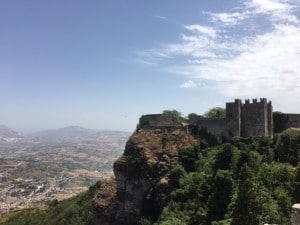
Barbara picked Sicily as her birthday present because for thousands of years people of different places and races — Phoenicians, Greeks, Carthaginians, Vandals, Goths, Normans, Spaniards, Jews, Muslims and Christians — fought over the island and left their marks. Some of them even shared it once in relative harmony. In the 12th century, under Norman kings Roger I and II and William I and II, Christians, Jews and Muslims lived together with some tension but with officially sanctioned tolerance. We wanted to see what they left behind.
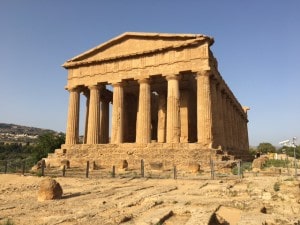
STARTING OUT
We chose to fly the Spanish airline Air Europa because it offers a good business class rate. The airline had emailed to announce that our 10:05 p.m. flight to Madrid on July 2 would now depart at 11:05. Did we want to keep the flight? We kept it, thinking we’d still have time to make the Ryanair flight that would take us on to Catania in Sicily.
Instead our flight departed well after midnight. I wore a warm-up suit over a T-shirt and tennis shorts for the overnight flight. Barbara wore an all-purpose blue print dress that allowed her to slip on a pair of workout leggings. We reached Madrid on Sunday July 3, collected our two bags and searched desperately for Ryanair.
Madrid’s Adolfo Suarez Barajas airport, one of Europe’s largest, is a black hole of confusion. Its signage and layout are atrocious. Nothing is obvious in the four terminals. We kept asking, “Where is Ryanair?” and finally found it by going through snack shop area. We barged the line and an agent told us to take our baggage and go back through security directly to the gate to try to make the flight.
The Spanish version of TSA rifled through the luggage that we normally would have checked and found gels and liquids. Barbara’s brand new tube of Curel moisturizer was too big. She told the agent to give it to his wife. “No permitido,” he said and tossed it.
Through security, we had to run through more food and shopping areas and a duty free section to reach the check-in gate. On the way I looked out to see the ground crew pushing a plane out to the taxiway. “That’s our plane,” I said. The gate agents had left the gate. We felt pitiful.
You get what you pay for with Ryanair and pity isn’t included. The airline didn’t have another flight to Catania until Wednesday. One left for Palermo on Monday. We like Madrid, but we wanted Sicily.
Still pulling our luggage around, I (Nick) found a ticket counter that represented a number of airlines. A very helpful woman searched for flights and found us the last two tickets on an Alitalia flight to Catania, changing in Rome. It cost over $1,000 euros for the two of us.
The flight to Rome left late, and taxied – the kind word would be “deliberately” — on the extremely long runaway out of Barajas. It crawled upon landing in Rome as well. We feared we’d miss the Catania flight and raced from the plane through the terminal down the stairs to reach the gate just as it was closing.
A cluster of people stood arguing trying to get on the plane as agents tried to close the doors. Barbara instantly realized they wanted to carry on luggage and pushed us through saying, “Catania. No luggage!” They took our tickets quickly and rushed us through the door to a bus that took us to the plane.
FINALLY CATANIA
When we reached Catania, the “no luggage” part turned out to be true. We stared at the carousel long after everyone on our flight left, but our luggage never showed up. We filed a report with Grazia Romico, who filled out the forms for us patiently and said, “Alitalia. This airline is good. It will turn up eventually.”
“Eventually” was the only part of that we didn’t like. But we were there! So I in my warm-up suit and tennis shoes and Barbara in her blue dress took a taxi to the Liberty Hotel with just the bare essentials in our very small carry-ons.
We arrived after eleven at night, hungry and eager for a glass of wine. Salvo, the hotel’s night man, directed us to Trattoria del Caviliere down the hill past an unearthed Roman amphitheater in a corner of the piazza in Catania’s Centro district.
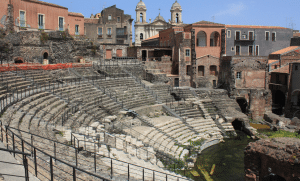
The menu featured horse, thus the restaurant’s name. We skipped it. Barbara ordered veal Milanese and I chose swordfish. We split a head of grilled radicchio and asked for refills on the prosecco.
The food and wine made us feel lucky to have made it to Sicily. Catania,we later learned, is renowned for its horse dishes. We got back to the hotel at one or so and fell into bed.
We felt pretty lucky about the Liberty Hotel, too. Its owners converted a 19th Century mansion into an elegant small hotel with comfortably furnished and immaculate rooms and modern bathrooms. And for 119.20 euros a night, it was a good deal.
The staff made it even better. That first night, Salvatore, the night manager, reassured us that Alitalia had a pretty good track record for recovering lost luggage. But he pointed out that it might take a few days.
So on Monday July 4 we set out to explore Catania, me in the tennis shorts and shirt and sneakers and Barbara in the blue print dress.
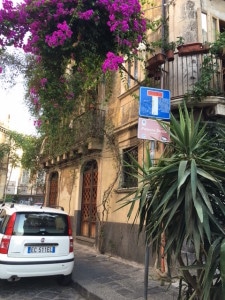
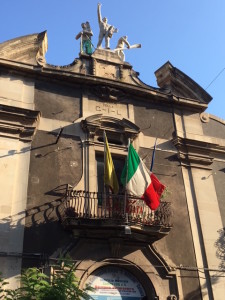
On our way to Catania’s Pescheria, or fish market, we walked down hill through the ancient narrow streets to Via Etna, the busy modern shopping area. Whether my luggage gets lost or not, I tend to under-pack (to make up for Barbara’s over-packing) and sometimes have to shop for extras.
On Catania’s major shopping street I saw a store with a name from the past: Sonny Bono. It turns out it’s an Italian brand with the motto “born trendy.” I wondered if Cher knew anything about it. It had nice stuff, and I found a pair of blue shorts and a white linen shirt that seemed just right.
Barbara, in the meantime, searched out underwear and we felt ready to tackle Catania’s famous market.
We headed through the Piazza Duomo, the town’s main square, dominated by a statue of a pygmy elephant, a symbol of the city and a reminder of the past. Catania, Sicily’s third largest city, dates to around 800 BC when Greeks landed here and built an Ionian Sea port. Arabs ruled much later, from the 8th to 11th Centuries. Fish, food and religion play big part in the culture.
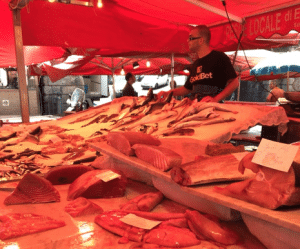
Steps led from a corner of the Piazza Duomo down into the busy Pesceria. Fishmongers shoveled ice over huge hunks of tuna and swordfish, flounder, sea bass, sardines, anchovies, octopus, squid, giant prawns, a variety of mollusks and called out to shoppers offering better prices than the stand next door. We wandered through it into adjacent streets where the fish stands gave way to butchers, salumeria and produce sellers.
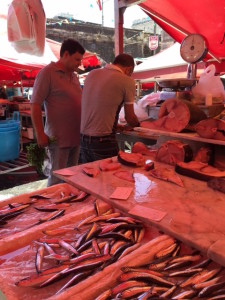
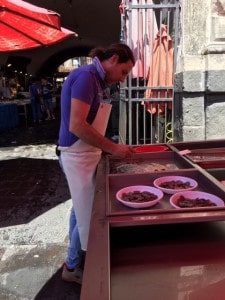
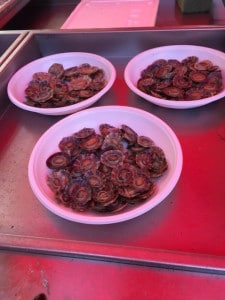
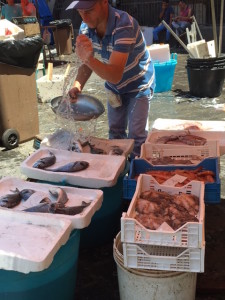
Barbara peered into the counters examining the different types of involtini, fish stuffed with pine nuts and raisins, chicken breasts stuffed with pistachios, beef stuffed with cheese, and said gleefully, “This is a home cook’s paradise. I could live here.”
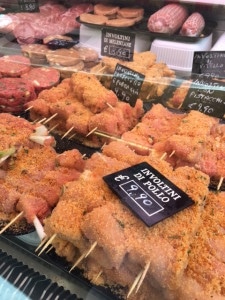
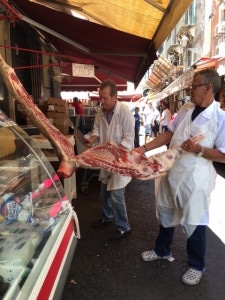 We explored the market until we worked up an appetite and discovered the Osteria Antica Marina in a corner of the fish market. We chose an outside table even though it was hot because we loved the view of the busy fishmongers and their customers.
We explored the market until we worked up an appetite and discovered the Osteria Antica Marina in a corner of the fish market. We chose an outside table even though it was hot because we loved the view of the busy fishmongers and their customers.
I ordered a pesce insalata mixta and Barbara picked octopus salad. We split an order of spaghetti with black squid ink, a favorite dish of Inspector Salvo Montalbano, Andrea Camilleri’s food-loving, fictional Sicilian detective.
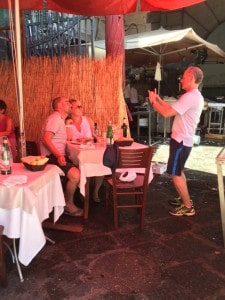
A young couple from Holland took a table on one side of us and an older couple from Germany sat on the other side. We talked to them both, first about the marvels of Sicily and the delicious food, after which they brought up Donald Trump. “Would America really elect someone like that? Don’t Americans understand the consequences of having an incompetent leader?” An Australian couple in the hotel that morning had plunged right into the same conversation.
After lunch we followed local custom and went back to the hotel for a nap. Everything shuts down from about 1:30 to 3:30.
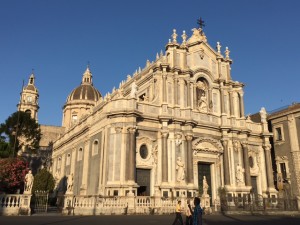
That afternoon, we explored Catania’s Sicilian Baroque heritage, which owes a debt to Mt. Etna. It was a clear day and you could see the volcano to the north. A 1669 eruption and an earthquake in 1693 destroyed Catania and gave Roman architects a blank canvas. Through the late 17th and early 18th Centuries they rebuilt the city in a baroque style, often using the black lava stone and adorned the flamboyant buildings with curves, lacey stone frills, putti and grinning masks.
We walked and walked through the hills of the neighborhoods and stopped at the 13th Century Castle Ursino, built by King Frederick II and once the home of Sicily’s parliament.
When we went back to the hotel to freshen up, we found Alberto the on-duty deskman, on the phone trying to track our luggage. This charming and helpful young man made it his mission to discover exactly where Alitalia had stowed the bags and what the airline planned to do. He told us they would be on the evening flight from Rome to Catania, but also suggested we plan ahead and think about having them sent to our hotel at our next destination.
About 9 p.m. we returned to the Piazza Duomo. We had learned about Ambasciata del Mare, a restaurant locals like, which sits in the corner of the piazza close to the fish market steps.
I asked the waiter for a wine recommendation and he introduced us to Murgo’s Etna Bianco, a light white wine with at least 60 percent carricante grapes grown on the slopes of Mt. Etna. We loved the smooth clear taste immediately. I ordered a raw fish antipasto and Barbara calamari fritti. Red mullet, another Salvo Montalbano favorite and one of ours when we can find it in New York, was on the menu and I had to have it. Barbara picked pasta with bottarga, or tuna eggs.
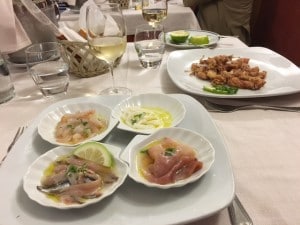
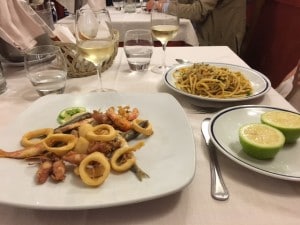 The restaurant continued to fill up through the evening with business people, family parties and what seemed like local couples who knew the menu well.
The restaurant continued to fill up through the evening with business people, family parties and what seemed like local couples who knew the menu well.
Back at the hotel, our luggage still had not arrived
The next morning, Tuesday July 5, the desk still had no news of our luggage when we went to breakfast. Did I mention that Sicilian breakfasts, generally included in the price of the room, feature a huge buffet filled with pistachio cakes, fruit cakes, fruit tortes, crumb cake, fruit, yoghurt, hard boiled and scrambled eggs, cold meats, bread, rolls, coffee or tea and juice?
The desk announced triumphantly that our luggage had arrived while we were eating breakfast and was in our room.
I removed my fashionable scruffy beard and put on my new Sonny Bono clothes. Barbara put on a clean dress. We checked out and ordered a taxi to take us to the nearby Hertz office. We got a nice Fiat sedan, a four-door Tipo with a diesel engine and stick shift, in metallic bronze, practically new.
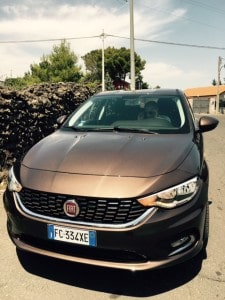
I ordered the Hertz “NeverLost” navigation system but that was a mistake, or at least it was a mistake not to get more thoroughly briefed in how to program it because we never figured out quite how to do it that. Anyway, we headed off happily to ascend the southern slope of Mt. Etna.
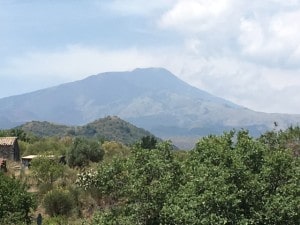
Our two weeks in Sicily didn’t include time explore the volcano, which rises 10,900 feet above the sea and is the tallest active volcano in Europe. But we wanted to get close. So we followed the signs that took us through small hillside villages on circular roads up the slopes.
Greek mythology had Heapestus, the god of the forge, working in the volcano. The Cyclops that menaced Odysseus supposedly lived there, too.
The volcano’s eruptions contribute to its legend. In 396 BC an eruption stopped the Carthaginans on their way to Siracusa, where we planned to go next.
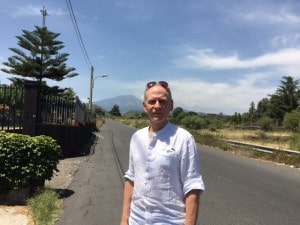
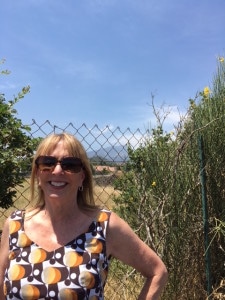
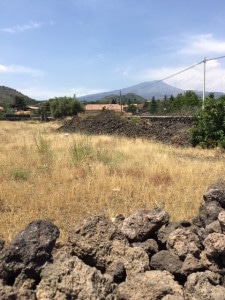 We took some pictures, Barbara collected a piece of lava rock, and we followed signs to the Autostrada to drive down to Siracusa. The city, anglicized as Syracuse, was once a capital for the Greeks that the Roman Cicero called, “the most beautiful of them all.”
We took some pictures, Barbara collected a piece of lava rock, and we followed signs to the Autostrada to drive down to Siracusa. The city, anglicized as Syracuse, was once a capital for the Greeks that the Roman Cicero called, “the most beautiful of them all.”
After about ninety minutes on the Autostrada we wound our way through Siracusa, onto a short bridge to the adjoining island of Ortigia, and through the narrow streets barely wide enough for our car.
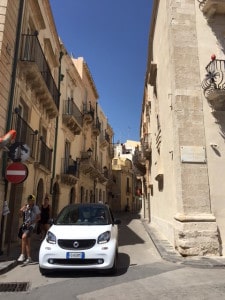
We’d read about the Algila’ Ortigia Charme Hotel in Francine Prose’s engaging NYT Travel Section piece on Sicily, and booked for two nights before we left New York. The hotel faced the Ionian Sea.
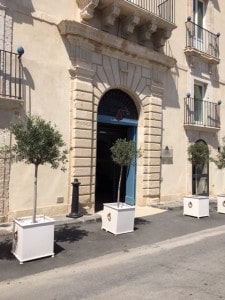
We found it charmé immediately because we love old cities and Ortigia falls among the oldest.
The jumble of stone houses crammed together reflect the mash-up of cultures and architectural styles of centuries of invaders and conquerers.
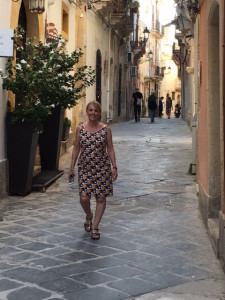
Phoenicians, creators of an alphabet and great sailors from the coasts of what is now Israel, Lebannon and Syria lived on Ortigia. But by the 8th Century BC, Greeks claimed the island and turned it into one of the most powerful Greek city-states. The Greeks warded off the Carthaginians in the 4th Century BC. But they weren’t strong enough to defeat the Romans in 212 B.C. Archimedes, a native son, mathematician, physicist. astronomer and engineer, died rather than submit to the Romans. The Byzantines captured the island in 535 A.D. and kept it until Muslims from Spain and north Africa invaded in the 9th Century. They ruled until the 11th Century when Norman conquerers displaced them. By the 15th Century, the Spanish ruled Sicily.
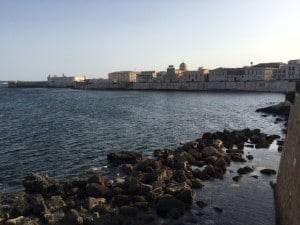
So the tiny island holds secrets from them all. Many of the original buildings were destroyed in the 1693 earthquake that hit the east coast of Sicily. But the Baroque building boom that followed left a distinct mark on the city.
A quick look around told us we would find romance here.
Our room with a sea view was in an annex across a narrow street from the main hotel in a restored Baroque building.
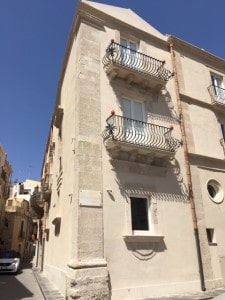
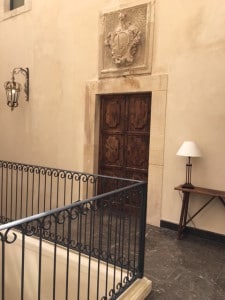
Carolina, the enthusiastic hotel staffer who led us to our room, described every detail of the construction and the attractive furnishings. She also told us about the ancient mikvah, a Jewish ritual bath, where we could take a tour.
Barbara said, “We have to go!” Jews may have come to the island with the Phoenicians and apparently Romans brought Jews to Ortigia as slaves after the fall of Jerusalem in the first century. By all accounts, the Jewish community thrived here until the Spanish Inquisition in 1492, when the world changed for Jews.
To find the mikvah, we followed a rising walk along the seawall past Siricusans swimming and sunbathing.
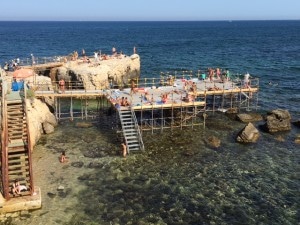
At what may have been the island’s highest point, we found the old Jewish section of the city, in Italian Giudecca.
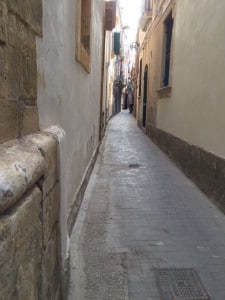
We walked along a narrow street and happened upon the ruins of a church that sits on top of what was once a synagogue.
We stepped into the roofless church and joined a wedding a progress. A violinist in a sleek sleeveless shift, wearing stilettos, played as the bridal party followed by the bride in strapless full-skirted gown walked down the aisle.
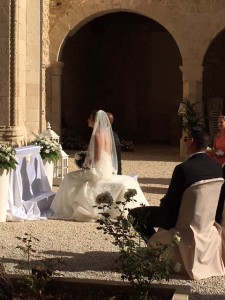
We stayed long enough to see someone rush to the front to provide the bride with a hand fan to cool off, and then went looking for the entrance to the mikvah.
A sign in the window of the Residence Hotel Alla Guidecca advertised the tour and we went inside to sign up for the next one. While we waited for it to begin, we grabbed a panini in a cafe in the nearby Piazza Giudecca.
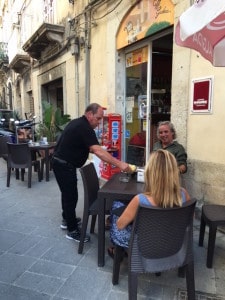
When we returned our young female guide led us and two other parties down a steep set of 48 limestone steps into a room with a vaulted ceiling hollowed out of bedrock. A ventilation shaft provided natural light. Unfortunately we couldn’t take pictures, but we can tell you the room made us gasp. Three pools were carved into the stone floor with steps for descending into the water, which still flowed from an ancient spring. Arches in adjoining alcoves led to similar pools of water, still fresh and cool.
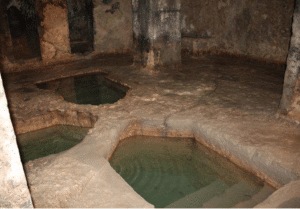
The 6th Century baths were discovered in 1987 when the hotelier began work to restore a palazzo once owned by the Jewish Bianchi family. Our guide told us that when the, Spanish who ruled Sicily then, forced the Jews to convert or flee in 1493, Jews buried the mikvah with dirt and rubble.
The guide spoke first in Italian and then in English to explain that 28 truckloads of dirt were carted out to make the baths accessible again.
Barbara writing here: I imagined ancient relatives using the baths walking nearby streets, working, raising children, praying, living their lives until the terror of the Inquisition scattered them across Europe. In this cool place, and on the winding streets of Ortigia I felt more connection with a personal past than I did during our travels to the Eastern European villages my grandparents fled.
We shared a heady feeling when we left the mikvah in the hour when the sun made the limestone buildings look golden.
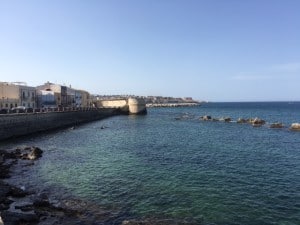
We stopped for a glass of prosecco at a bar overlooking the waterfront. Two Australians were drinking beer at the next table and we struck up a conversation.
They with their wives and two other couples were on a long trip away and had come to Sicily from Malta. Their international airfreight business represented Hawaiian Airlines and they also did business with mainland U.S. companies. They told us they admired Obama. “We wish our country had a statesman like Obama,” one said. Both were appalled by Trump. “Vote. You have to vote, and tell your friends to vote,” Allan Mayne, the more vocal of the two, said. They talked about their country’s politics and the gridlock in their parliament that made it impossible for anything constructive to happen.
We liked them, and when they recommended a place they had been on Sicily’s northwest coast between Trapani and Palermo, a town called Scopello, we took it seriously.
We had booked only Catania and Siracusa in advance. Before we left home, our New York friends Mimi Taft and Frank Lupo, whose family lives south of Siracusa, showed us pictures of places they love and recommended must-see places. One of them was Noto, a Baroque city south of Siracusa. The Australians disagreed with a snarky, “Say ‘no’ to Noto.”
As we pondered our next destination, we ate that night at Sicilia in Tavola, a five-minute walk from the hotel, at a table set up in an alleyway called Via Cavour. We ordered the white wine favored by the owner’s brother and studied the menu.
To start, Barbara had a casserecci con la bottarga tuna and it was as good as the first time in Catania. Nick chose casserecci con le sarde, a pasta with fennel and sardines and he wanted to bury his face in the food.
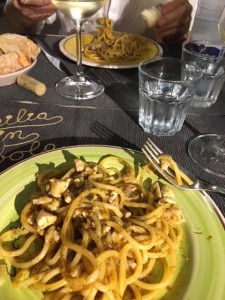
But we did move on to a main course of swordfish for Nick and tuna for Barbara.
We walked a bit after dinner and wound our way through the streets to a big piazza that faced the remains of the Temple of Apollo. The 6th century BC temple became a church, then a mosque, and a church again before falling into ruin. It or what’s left of it is the oldest Doric temple in Western Europe.
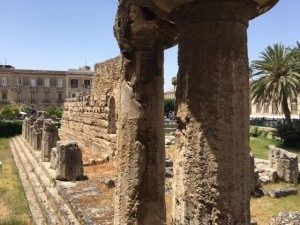
We got another look at the Temple of Apollo the next morning on our way to visit the Neapolis Archaeological Park in mainland Siracusa, home to ancient sites including a 5th century BC Greek amphitheater carved out of a marble hillside.
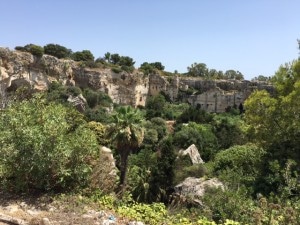
We walked for twenty minutes through a mostly nondescript commercial area. Once in the park, we climbed a hill to the theater and marveled at the construction and the view of the blue Ionian Sea.
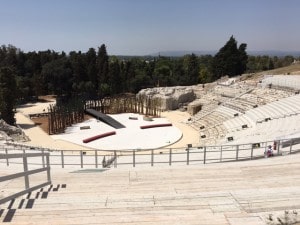 Remarkably, it’s still in use. Some of the lower parts closer to the stage were roped off because a production was going on and the stage and scenery were in place. Today’s theatergoers watch the action from wooden seats that are laid down over much of the original stone.
Remarkably, it’s still in use. Some of the lower parts closer to the stage were roped off because a production was going on and the stage and scenery were in place. Today’s theatergoers watch the action from wooden seats that are laid down over much of the original stone.
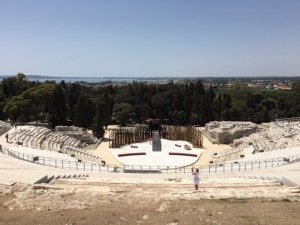
There’s a Roman amphitheater in the park as well. There were dramatic differences. The Greeks put on plays and used a stage. The Romans staged spectacles including circuses and combat, so offstage they ihttps://www.consumermojo.com/a-romantic-trip-to-sicily-part-one/nstalled barred doorways and cages for animals and slaves.
We had not seen a cloud in the sky so far in Sicily. This day was no different, bright sun and temperatures close to 90 F, and so after browsing the archaeological park we took a taxi back to Ortigia and the market there for lunch.
Ortigia’s market was much smaller than Catania’s – Siricusa is half the size of Catania, though it was once five times larger – but it, too, buzzed with fish and meat and vegetable and spice sellers.
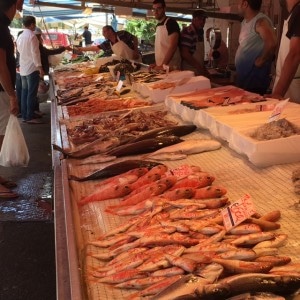
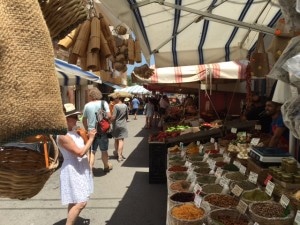
We met Alexandro Romano, who drove up from Pozzallo, south of Noto, to sell his family’s spices and nuts. He told us about carrettierra, a blend of herbs and spices that he said with a little olive oil, cherry tomatoes and red wine would turn pasta into a simple, delicious meal. He describes it in this video:
Then we found our way to Fratelli Burgio at the end of the market street. The store looked like a grocery store, or salumeria inside.
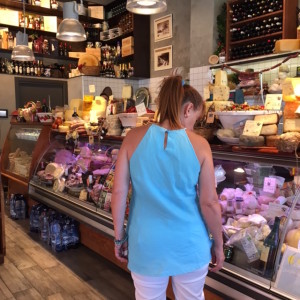
Outside people eating prosciutto and other meats and sandwiches packed rows of picnic tables. We found seats and ordered smoked fish panini, Barbara thinly-sliced tuna with zucchini and Nick swordfish with cheese. They went down nicely with glasses of vino bianco.
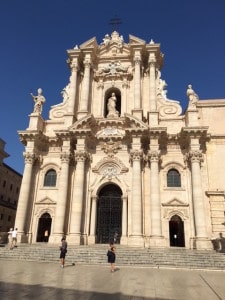
After the afternoon nap, we headed for the Piazza di Duomo and explored the Baroque church in the square paved with dark marble.
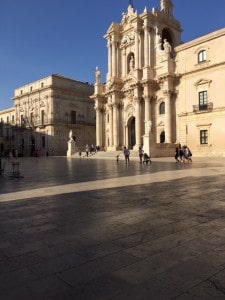
We had hoped to see the Caravaggio painting in the church of Santa Lucia, but the painting was on tour. We stopped instead at a contemporary art gallery and learned a little about what young Sicilian artists are thinking. One artist crocheted a pistol in white wool.
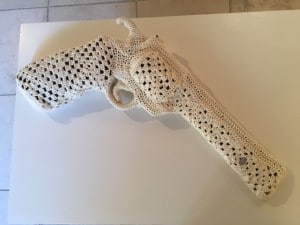
The late afternoon light drew us back to the Temple of Apollo and we enjoyed a glass of wine across the square and watched an Ortigian try who lived overlooking the Temple attempt to fix his TV antenna. Here’s the video:
The restaurant at the Hotel Algila Ortigia Charme had a menu, that looked more inventive than most and we decided to try it. Nick ordered octopus and Granny Smith apple salad to start and pork belly and shrimp pasta for a main course. Barbara started with a salad of red prawns and oranges. The shrimp were the sweetest that we’ve ever tasted. Her main dish of sea bass ravioli was equally delicious. Again, we chose a bottle of Etna bianco to accompany the meal.
The next morning, Thursday July 7, we checked out and headed south to give a nod to Noto.
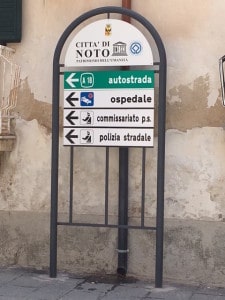
A drive-through showed us enough of its Baroque facades.
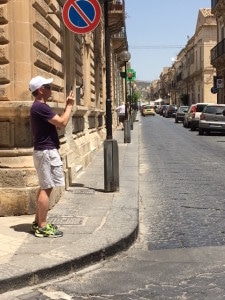
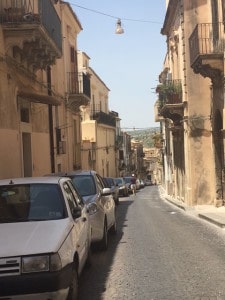
Then we angled west and north toward Piazza Armerina, the jumping off point for a visit to Villa Romana del Casale and its remarkable collection of mosaics.
All photos and videos shot with our iPhones.
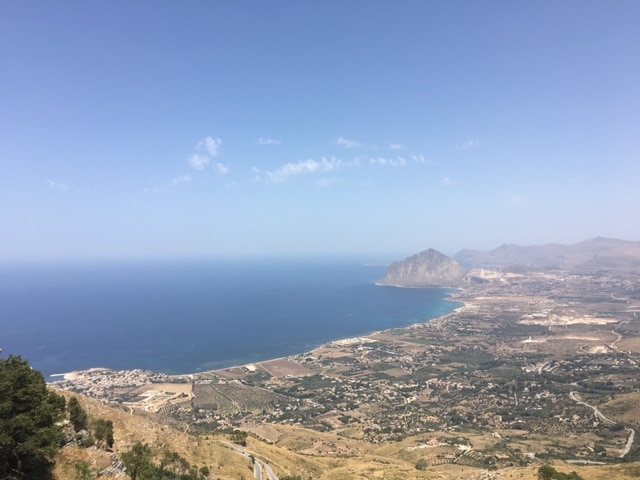
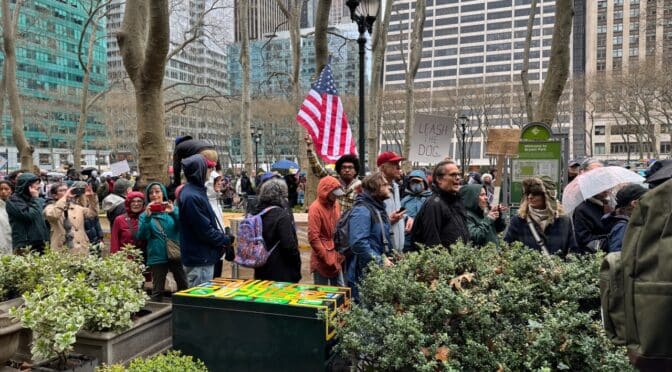

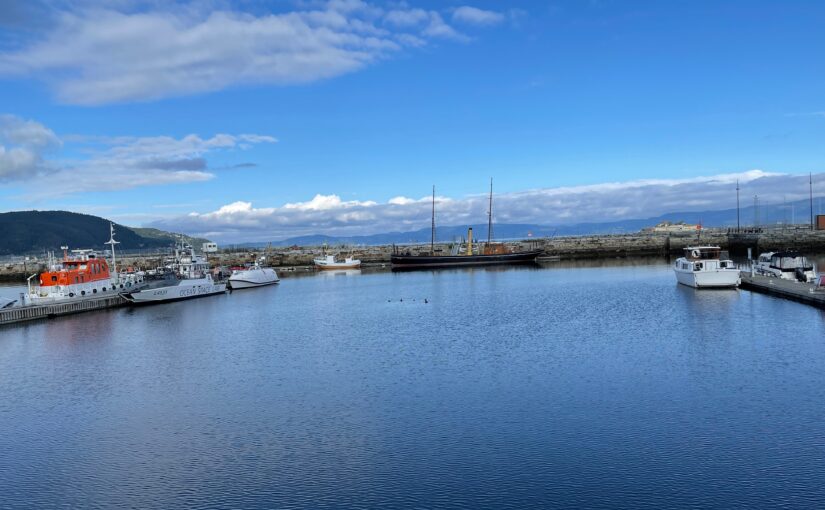

Can’t wait for the next Part. Thoroughly enjoyed. I almost smelled the fish market..
Thanks very much! We’re working on it now. — Nick